Heritage Gateways
Official Sesquicentennial K-12 Education Projectsponsored by the Utah State Board of Education, the BYU-Public School Partnership and the Utah Education Network
Pioneer 1848-1868 Companies
1856-60, Handcarts: Construction Plans (Steve Pratt)
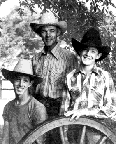
Pioneer Handcarts
Copyright 1989 by Stephen Pratt
3rd Printing 1996 Art by Monica Brian
All rights reserved
Pratt Wagon Works
Cove Fort, UT, 84713
1856-1860
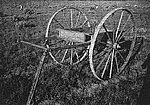 The cart pictured is a meticulous reproduction of the cart described by Brigham Young in his letter of September, 1855. The spokes were made by the hand carving of many different young guests who attended the Castle Valley Pageant near Castledale, Utah during the summer of 1990. Following one of Brigham Young's options, the cart is constructed without "a particle of iron." This cart was loaded and pulled several miles to test and age it. It served very well on the short journey. In 1993, this replica handcart was purchased by the LDS church and placed on display in the newly remodeled and rededicated Joseph Smith Memorial Building (formerly the Hotel Utah) across the street from Temple Square in Salt Lake City, Utah.
The cart pictured is a meticulous reproduction of the cart described by Brigham Young in his letter of September, 1855. The spokes were made by the hand carving of many different young guests who attended the Castle Valley Pageant near Castledale, Utah during the summer of 1990. Following one of Brigham Young's options, the cart is constructed without "a particle of iron." This cart was loaded and pulled several miles to test and age it. It served very well on the short journey. In 1993, this replica handcart was purchased by the LDS church and placed on display in the newly remodeled and rededicated Joseph Smith Memorial Building (formerly the Hotel Utah) across the street from Temple Square in Salt Lake City, Utah.
About three years ago my teenage sons and I were invited to build eighteen handcart wheels and nine axles for use in Utah pioneer parades. The question was asked, what did they look like? Did they simply use carriage or light wagon wheels? had the "Sarven Hub" been invented with its two steel flanges that entirely cover the wooden core into which the spokes are driven? Were the hubs held on with big square blocks of wood as seen in one well known sculpture? Were the axles steel or wood? What kind of bearing surface was used? Were they greased or dry? We built eighteen wooden wheels, but later discovered that they were quite different in design from the wheels and axles described by the pioneers of 1855 to 1860.
In this paper we shall attempt to reconstruct the real pioneer handcarts as they most likely were assembled. We will invite the reader to view hand cart design through the eyes of a meticulous craftsman skilled in both wheel construction (wheelwright) and wagon making (wainwright). In addition this craftsman has a zealous interest in American history and period authenticity. It is hoped that this will shed additional light on the scholarly works of the historians and the interpretations of the artists. It is also hoped that those who enthusiastically collect artifacts, as we do, will find this paper useful in evaluating their findings. Most important of all we hope many people will use these plans as working drawings to construct time period authentic carts. In this way the hearts of the children can be turned to their fathers that future generations may be blessed.
The following drawings and sketches have been constructed from about ten different references coming from the pioneer time period. Consider for example the following excerpt out of a letter from Brigham Young during September of 1855:
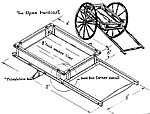 "I will give you my plan of building the carts take Iron Wood or Hard Hack for Hubs, turn them out about six inches long and five or six inches in the diameter, the axle trees should be of good hickory about 2 inches in diameter at the shoulder, and one and a quarter at the point, and about, four and a half, feet from point-to point, the hubs should be lined for boxes, with sole leather. The spokes should be turned or shaved out of hickory, long enough so as to make the wheel about four and a half, or five feet high. The spokes should be set bracing in the hub and seasoned. It will draw much easier built high than low so that the shafts may draw level; split out rims from good hickory, something like spinning wheel rims only thicker, and fasten them through and through with green hide and cover them also with the same when it can be done, the beds should be made out of one half inch stuff in order to be light, as possible. You will not need a particle of Iron and the brethren can come along with no trouble or perplexity of teams and save a great deal of expense. " (Original letter in LDS Church Archives) of wood and as orderly as may be in the following manner-prior to the time of starting some mechanics accustomed to working in wood with a turning lathe, making wheels, etc., should be picked up to go to the outfitting point and gather good timber for the purpose, and commence turning hubs, spokes, etc., and making the carts..." (Original letter in LDS Archives)
"I will give you my plan of building the carts take Iron Wood or Hard Hack for Hubs, turn them out about six inches long and five or six inches in the diameter, the axle trees should be of good hickory about 2 inches in diameter at the shoulder, and one and a quarter at the point, and about, four and a half, feet from point-to point, the hubs should be lined for boxes, with sole leather. The spokes should be turned or shaved out of hickory, long enough so as to make the wheel about four and a half, or five feet high. The spokes should be set bracing in the hub and seasoned. It will draw much easier built high than low so that the shafts may draw level; split out rims from good hickory, something like spinning wheel rims only thicker, and fasten them through and through with green hide and cover them also with the same when it can be done, the beds should be made out of one half inch stuff in order to be light, as possible. You will not need a particle of Iron and the brethren can come along with no trouble or perplexity of teams and save a great deal of expense. " (Original letter in LDS Church Archives) of wood and as orderly as may be in the following manner-prior to the time of starting some mechanics accustomed to working in wood with a turning lathe, making wheels, etc., should be picked up to go to the outfitting point and gather good timber for the purpose, and commence turning hubs, spokes, etc., and making the carts..." (Original letter in LDS Archives)
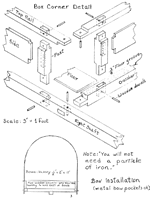 Let us examine one more description by a veteran of the handcart emigration, J. Rogerson:
Let us examine one more description by a veteran of the handcart emigration, J. Rogerson:
"The open handcart was made of Iowa hickory or oak, the shafts and side pieces of the same material, but the axles generally of hickory. In length the side pieces and shafts were about six or seven feet, with three or four binding cross bars from the back part to the fore part of the body of the cart; then two or three feet space from the latter bar to the front bar...
"The carts were the usual width of the wide track wagon. Across the bars of the bed of the cart we generally sewed a strip of bed ticking or a counterpane [bed sheet]. On this wooden cart of a thimbleless axle, with about a 2 1/2 inch shoulder and one inch point, were often loaded 400 or 500 pounds of flour, bedding, extra clothing, cooking utensils and a tent. How the flimsy Yankee hickory structure held up the load for hundreds of miles has been a wonder to us since then." Josiah Rogerson, in the Salt Lake Tribune, Jan. 4, 1914 as quoted in Handcarts to Zion p. 54 - 55.
Attempting to follow the instructions from their leaders, during the first year, one-thousand-eight-hundred-and-ninety-one pioneers began moving west. They pushed and pulled their supplies in 430 handcarts and 27 wagons. The first company to leave in 1856, departed from Iowa City on June 9. The last company to move west by handcart in 1856, left Iowa City on July 28. This group that departed so late in the season was known as the Martin Company. In October they faced terrible trials when early winter storms caught them still hundreds of miles from their destination.
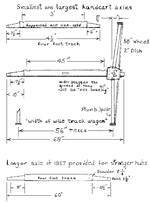 As the companies pushed their carts across Iowa, grit began to grind away the unprotected wooden spindles of the axles. Fortunately for the first company, Joseph Argyle, a tinner by trade, was able to wrap every spindle with tin. Other companies were not so fortunate. J. H. Latey wrote from Florence on August 14 and reported the arrival of the fourth company (Willie s Company). He wrote, "The companies stay here longer than they otherwise would in consequence of their carts being unfit for their journey across the Plains; some requiring new axles, and the whole of them having to have a piece of iron screwed on to prevent the wheel from wearing away the wood." Millennial Star, XVIII, p. 638, as reported in Handcarts to Zion, p. 94.
As the companies pushed their carts across Iowa, grit began to grind away the unprotected wooden spindles of the axles. Fortunately for the first company, Joseph Argyle, a tinner by trade, was able to wrap every spindle with tin. Other companies were not so fortunate. J. H. Latey wrote from Florence on August 14 and reported the arrival of the fourth company (Willie s Company). He wrote, "The companies stay here longer than they otherwise would in consequence of their carts being unfit for their journey across the Plains; some requiring new axles, and the whole of them having to have a piece of iron screwed on to prevent the wheel from wearing away the wood." Millennial Star, XVIII, p. 638, as reported in Handcarts to Zion, p. 94.
Remember now, that during this first year of handcart t transportation 430 carts were launched. During the next four years a total of only 223 more carts crossed the 1300 mile wilderness to Utah. The point is that 2/3 of the carts left during 1856. These first 430 carts were constructed by craftsmen following the same guide-lines. John Chislett, an eye-witness and participant in the Fourth Company, described some of their transportation woes:
"We started from Florence about the 18th of August, and traveled in the same way as through Iowa, except that our carts were more heavily laden, as our teams could not haul sufficient flour to last us to Utah; it was therefore decided to put one sack (ninety-eight pounds) on each cart in additional to the regular baggage...
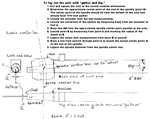 "The only drawbacks to this part of our journey were the constant breaking down of carts and the delays caused by repairing them. The axles and boxes being of wood, and being ground out by the dust that found its way there in spite of our efforts to keep it out, together with the extra weight put on the carts, had the effect of breaking the axles at the shoulder. All kinds of expedients were resorted to as remedies for the growing evil, but with variable success. Some wrapped their axles with leather obtained from bootlegs; others with tin, obtained by sacrificing tin-plates, kettles, or buckets from their mess outfit. Besides these inconveniences, there was felt a great lack of a proper lubricator. Of anything suitable for this purpose we had none at all. The poor folks had to use their bacon (already totally insufficient for their wants) to grease their axles, and some even used their soap, of which they had very little, to make their carts trundle somewhat easier. In about twenty days, however, the flour being consumed, breakdowns became less frequent, and we jogged along finely..." Chislett in Stenhouse, op. cit., 317-318, Handcarts to Zion, p. 99-100.
"The only drawbacks to this part of our journey were the constant breaking down of carts and the delays caused by repairing them. The axles and boxes being of wood, and being ground out by the dust that found its way there in spite of our efforts to keep it out, together with the extra weight put on the carts, had the effect of breaking the axles at the shoulder. All kinds of expedients were resorted to as remedies for the growing evil, but with variable success. Some wrapped their axles with leather obtained from bootlegs; others with tin, obtained by sacrificing tin-plates, kettles, or buckets from their mess outfit. Besides these inconveniences, there was felt a great lack of a proper lubricator. Of anything suitable for this purpose we had none at all. The poor folks had to use their bacon (already totally insufficient for their wants) to grease their axles, and some even used their soap, of which they had very little, to make their carts trundle somewhat easier. In about twenty days, however, the flour being consumed, breakdowns became less frequent, and we jogged along finely..." Chislett in Stenhouse, op. cit., 317-318, Handcarts to Zion, p. 99-100.
What are the "boxes" of wood being ground out by the dust? This point of clarification may help the reader. In pioneer wheel terminology, the "box" is the smooth, round, tapered hole inside the hub that slips over the spindle on the end of the axle. It was best in pioneer days to press a tapered cast iron sleeve into the box to provide a more durable surface. The metal insert is called the "boxing". Brigham Young instructed them to" "line the inside of the hub with good sole leather for boxes.
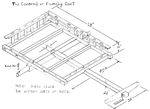
What is a "thimbleless axle"? The spindle is the bearing surface on the end of the axle. It was best to cover the wood with a protective thimble made of metal. This thimble is more often called the skein. In desperation, and far from their point of departure, the handcart service technicians protected the wooden spindles with metal from their tin-plates, kettles and buckets or screwed on a piece of iron to prevent the wheel from wearing away the wooden spindle. The spindle needs the most protection on the bottom side because the load is always pressing the spindle DOWN on the inside of the rotating hub. We have seen several iron skeins on wagons, where the bottom of the skein is completely worn through to the wood, while the top of the skein is still very thick and usable. An excellent example of protecting the wooden spindle with a strap of iron on the bottom can be seen in the Daughters of the Utah Pioneers Museum in Pleasant Grove, Utah. Very simply, a piece of flat iron strap is mortised into the bottom of the wooden axle. The iron must be forged, fit, and filed to blend with the smooth circular spindle surface.
PART II: THE NEW AND IMPROVED CART OF 1857
Following the great effort of 1856 to help poor travelers to emigrate to Utah, a dramatic and successful demonstration of the efficiency of handcart travel was needed to restore the humble vehicle to favor. In the fall of 1856 the First Presidency suggested that elders being sent on missions from Utah take handcarts and cross the plains on foot. On December 10, 1856, a message from the First Presidency was printed in the Deseret News. Regarding handcart design they counseled: EMIGRANTS MUST BE PROVIDED WITH STRONGER HANDCARTS. By spring the travel plan for departing elders was adopted and on April 23, 1857, about seventy missionaries set out from Salt Lake City in a handcart train with no support wagon. So far, we have found nothing to verify the design improvements utilized in the missionary carts. However, when they arrived in Florence, a representative from the newspaper interviewed them and reported:
"The bodies of the carts were tastefully painted to suit the fancy of the owners, and with such inscriptions on the sides as: "Truth will Prevail,"Zions Express," "Blessings follow Sacrifice," "Merry Mormons." They had canvas covers, and were better looking vehicles in every respect than we had expected to see. From the accounts published in the leading journals throughout the country, the general impression on the mind of the public is that the handcart is the slowest and most laborious mode of conveyance that can be used. From the report of this party and of others, we are inclined to think it exactly the reverse. This party was but nineteen days in coming from Fort Laramie, a distance of 520 miles- an average of over 27 miles per day- some days they made 35 miles. This is certainly not slow traveling...
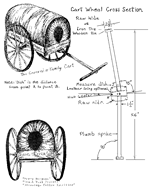 "The members of the party were Elders going on missions to different parts of the world. They were feeling fine after their trip and expressed themselves to be on hand for a foot race or wrestling match with any one in Florence who might feel inclined to indulge. The party sold their wagons [carts] at auction at prices ranging from eight to twelve dollars. They cost forty dollars to build, in the [Salt Lake] Valley." Florence Courier, reproduced in the Journal History, as reported in Handcarts to Zion, p. 147-8. With the light of hind sight, the missionary carts must have been a great improvement over the economy models of 1856. Note that they were tastefully painted, had canvas tops, averaged over 27 miles per day, and sold used for eight to twelve dollars. In planning for carts in 1856 it was estimated that they could be built for "only four or five dollars." The light of reason seems to indicate that these were not the frail carts of 1856 with their small hubs and thimbleless axles. So, what improvements did the craftsmen implement?
"The members of the party were Elders going on missions to different parts of the world. They were feeling fine after their trip and expressed themselves to be on hand for a foot race or wrestling match with any one in Florence who might feel inclined to indulge. The party sold their wagons [carts] at auction at prices ranging from eight to twelve dollars. They cost forty dollars to build, in the [Salt Lake] Valley." Florence Courier, reproduced in the Journal History, as reported in Handcarts to Zion, p. 147-8. With the light of hind sight, the missionary carts must have been a great improvement over the economy models of 1856. Note that they were tastefully painted, had canvas tops, averaged over 27 miles per day, and sold used for eight to twelve dollars. In planning for carts in 1856 it was estimated that they could be built for "only four or five dollars." The light of reason seems to indicate that these were not the frail carts of 1856 with their small hubs and thimbleless axles. So, what improvements did the craftsmen implement?
After an eyewitness account in Salt Lake City of arriving handcarts and the people that pulled them; after interviewing the new emigrants and studying the mechanical deficiencies of the economy carts; the First Presidency compiled the data for the recommended changes. Their message of encouragement to future handcart travelers was published in the Deseret News of December 10, 1856 and in the Millennial Star of April 18, 1857. The message included these construction guidelines:
"They must be provided with stronger hand-carts... The hub or nave of the cart wheels should be eight inches long and seven inches through the centre. The boxes at the shoulder should be two-and-a-quarter inches, and the point boxes one-and-a-half inches in diameter.
"If it should be considered best to have cast iron arms, they should be one-and-a-quarter inches thick at the shoulder and three-quarters inch at the point. The wooden axles should have iron or steel skeins, and the wheels should be bound with band iron one-quarter or three-eights of an inch in thickness, with a dish of two inches, and track four feet apart. The timber must be of the best quality for toughness, and be well seasoned. In other respects they may be constructed as heretofore."
If these guidelines were followed, then the new carts had larger hubs, metal skeins with a plumb spoke taper for a two inch dish, a four foot track and very dry wood. (This terminology should make more sense as the reader studies the drawings.)
On June 6, 1860, Henry J. Harrison wrote in his diary a description of his cart. His cargo box was four feet long and three feet wide, the wheels four feet high, and the bed nine inches deep. He was instructed to grease the wheels three times each week. His four foot wheels were smaller than the recommended wheels of 54 to 60 inches. The craftsmen were instructed to build the wheels tall so the carts would be easier to pull. The axle was to be at a height which would put the shafts level when the cart was being pulled by a man. This requires a 54 to 60 inch wheel for the men of that time period. Perhaps Henry Harrison was a few inches shorter than average.
Daniel Robinson was captain of the Ninth Handcart Company. They were organized with 233 persons, 43 handcarts, six wagons and 38 oxen. During June of 1860 he wrote: "When we were called to team up, six teams were put to lead, the carts were in the rear. The people pushed the carts. The boxes and carts were painted beautifully, and had bows over the top. These bows were covered with heavy canvas. The tongues of the carts had a crosspiece 2 1/2 feet long fastened to the end. Against this crosspiece two persons would lean their weight, this they called pushing instead of pulling. It was very common to see young girls between the ages of 16 and 20 with a harness on their shoulders in the shape of a halter, a small chain fastened to that, and then fastened to the cart. There were some four or five to a cart some pushing, some pulling all day long through the hot, dry sand, with hardly enough to eat to keep life in their bodies." Daniel Robinson Account, in Carter, Treasures of Pioneer History, v, pp. 287-88, as quoted in Handcarts to Zion, p 181-82.
It appears that Captain Robinson is speaking in general terms about the majority of the 43 carts in his company. Note that instead of shafts and a crossbar, they used a tongue and a crosspiece with three people working up front.
PART III: SUMMARY OF DATA
- WHEELS: 4 1/2 to 5 feet tall with 2 inches of dish RIMS: Bent like the rim of a spinning wheel but thicker. (The rim of spinning wheels was bent out of one continuous, green white oak split about 1/4 inch thick. It was tapered and pegged at the joint. See Foxfire II, p. 194.) OR Saw rims 2 1/2 to 3 inches wide and 3/4 inch thick, then bend circle from either one or two pieces. (Dry wood this thick can be boiled or steamed and bent around a form.) Bore a round hole to receive the spoke tenon. Round the inside corners to shed sand.
- TIRES: Raw hide or preferably iron from 3/16 to 3/8 inch thick. (Both materials must be correctly installed with a very tight shrink fit to make a strong wheel.)
- SPOKES: Hickory or white oak. The number of spokes and size of the spokes is not given. Judging from the size of the hub and the loading of 400 to 500 pounds per cart, the small hubs would have used either 10 or 12 spokes measuring 1 3/8 inches at the hub. The larger hubs probably would have used 12 spokes each, measuring 1 1/2 inches at the hub. Use "Warner" style spokes, which have a square shoulder to seat firmly against the web of the hub. To be shaved with a draw knife or turned on lathe. Tenons of about 3/4 inch diameter cut with a tenon auger. HUBS: Turned round on a lathe. At first they tried 5 or 6 inches in diameter and 6 inches long. Beginning in December of 1856 it was recommended hubs be 7 inches in diameter and 8 inches long. (Before driving the spokes, wrap the hub tightly with wet raw hide and let dry thoroughly. Peg the ends of the wet rawhide in place. The mortises should be staggered about 5/8 inch.)
- BOXINGS: The recommendation to use wooden boxes lined with leather was never changed in any further message that we can find. "Many" of the hubs were not lined with leather. The hub box was simply wood turning on the axle spindle.
- AXLES: Hickory, 2 1/2 x 3 1/2 inches, from 54 to 70 inches long. (The length of the axle is determined by the length of the hub, the track, the cargo box size and clearances. Some axles were built for a 4 foot track. Others were built to follow the track of a "wide track wagon." In the mid eighteen hundreds, the track of a typical wagon was about 56 to 60 inches.)
- SPINDLES: From 2 1/4 inches at the shoulder and 1 1/4 inches at the point to 2 1/2 inches at the shoulder and 1 1/2 inches at the point. The improved carts were supposed to use metal skeins. An iron strip inserted into the axle would suffice. (Spindles are tapered in order that the vehicle can go over uneven surfaces with the least possible binding or friction. The "gather" is to keep the wheel running close to the shoulder. Gather keeps the wheel from crowding the axle nut or linch pin. The taper of the spindle or skein is important. To stand the wheels on a plumb spoke, one must utilize a "plumb spoke taper." Too much taper raises the outer end of the spindle higher than the shoulder with the tendency of the wheel to work off. The spindle must be cut with the proper "dip" or "draft" according to the dish and height of the wheel.)
- CARGO BOX: Depends on the axle length. On the short axle about 36 inches by 48 inches. On the axle set to the track of a wagon, a box of about 45 inches by 58 inches would be practical. The sides were either made of thin boards about 3/8 thick or they could be made of slats. The sides were 8 to 9 inches high. Six to seven foot long shafts along the sides. The improved bottom was thin boards over two or three crossbars. Literally boxes on wheels.
- CRAFTSMEN: "People skilled in lathe turning and wheel construction should commence making carts."
- FAMILY CARTS: Covered with canvas over three hickory bows. Bow size about 1/2 x 2 x 11" . Stronger than the open carts. Some utilized a tongue with crosspiece instead of shafts and crossbar.
- JOINERY: They were encouraged to use raw hide. The craftsmen were reminded that "you will not need a particle of iron." Joints typical of the mid eighteen hundreds can be seen on the drawings. No need to plane or polish. May be left rough sawn or hewn with the exception of the spindles and where the hands grip the shafts and crosspiece.
- PAINT Some of the later carts were colorfully painted including inscriptions. The most common color for the undercarriage was "red lead" which is a dull orange color. Cargo box and shafts were probably blue with artistic designs of white blue and red lead common during that time period. The art work looks very much like our modern "tole painting."
- TOOLS: Lathe, drawknife, shaving horse, mallet, auger, bits, chisels, frame saw, bucksaw, froe, froe club, adz, knife, tenon auger, spoke pointer, traveler, forge, anvil, striker (hammer), tire upsetter, caliper, divider, hub boring machine.
- WOOD: Used whatever hardwood could be found. Most of it white oak and hickory.
SUGGESTED MATERIALS LIST FOR THE OPEN HANDCART OF 1857
Source: Pioneer Handcarts 1856 - 1860 © Steve Pratt2 Shafts 1 1/2" x 2" x 7"
8 post 1 1/2" x 1 1/2" x 8"
2 crossbars 1 1/2" x 2 x 36"
2 crossbars 1 1/2" x 1 1/4" x 36 (floor lays on top of these) floor 3/8" thick x 45 5/8" (random widths as needed)
2 top rails 1" x 1 1/2" x 48"
2 top rails 1" x 1 1/2" x 36"
1 axle 2 1/2" x 3 1/2" x 60
2 naves from which to turn hubs 8" long x 7" diameter
24 1 1/2" spokes 30" long
2 rims for wheels 3/4" thick x 2 1/2" wide x 54 to 60 dia.
60" of 1/4" wooden dowels for pins
2 3/8" carriage bolts or 1/2" dowels to secure shafts to axles raw hide as needed for lashing
2 3/16" x 2 1/2" x 16" flat iron strap for tires
2 linch pins 3/8" x 7/8" x 4"
2 side boards 3/8" x 5" about 42" long
2 side boards 3/8" x 5" about 30" long
1 flat iron strap 1/4" x 1 1/2" x 60" (mortise under axle)
1 front crossbar 1 1/2" x 1 1/2" x 36"
These materials have been created by Steve Pratt. Copies of these materials may be reproduced for teacher and classroom use. When distributing these materials, credit must be given to Steve Pratt. These materials may not be published, in whole or part, or in any other format, without the written permission of Mr. Pratt, Cove Fort, Beaver, Utah 84713.